Working Out While Pregnant

When I speak with new mothers, I am surprised that many are misinformed or unaware of options for prenatal exercise. Digging a little deeper, I found a study found that one-third of women surveyed did not receive advice about physical activity during prenatal care [1]. In this article you’ll learn more about:
- How to monitor yourself while working out when pregnant
- The research behind why it is safe for most women to continue to workout while pregnant
- What the American College of OBGYN recommends for weekly physical activity
There are exercises and various strategies you can take to make working out while pregnant comfortable, safe, and effective. Understanding what to monitor when working out and what exercises may be right for you can improve your delivery process, protect you against eclampsia (high blood pressure during pregnancy), improve gestational weight, and lower risk of depression [2].
Keep in mind that every pregnancy is different. There are examples of women who did CrossFit or ran until they delivered their baby. This does not mean that it is the right path for you. Be mindful of your precautions and monitor your body’s response during and after exercise. This will set yourself up for success.
Working Out While Pregnant
How To Monitor Yourself To See If Exercise Is Appropriate For You
All pregnant women can participate in physical activity throughout pregnancy with the exception of the contraindications (AKA advised against) listed below:
- Red Light (Absolute Contraindications): Stop! Consult a health care professional and note exercise may not be appropriate for you if you have:
- Severe respiratory disease, severe acquired or congenital heart disease with exercise intolerance, uncontrolled or severe arrhythmia, placenta abruption, vasa previa, uncontrolled type 1 diabetes, intrauterine growth restriction, active preterm labour, severe pre-eclampsia, cervical insufficiency [2]
- Yellow Light (Relative Contraindications): Proceed with caution and do not hesitate to address your concern or questions with your health care provider if you have:
- Mild Respiratory disorders, mild congenital or acquired Heart Disease, well-controlled type 1 diabetes, mild pre-eclampsia, preterm premature rupture of membranes, placenta previa after 28 weeks, untreated thyroid disease, symptomatic severe eating disorder, multiple nutrient deficiencies, mod-heavy smoking (>20 cigarettes per day)
- Green Light: Any other circumstance; whether you were active or not before becoming pregnant! [2]
Be sure if you are going to continue working out while pregnant that you are monitoring your heart rate, and be sure that you are able to talk during the workout. This will help you keep an intensity that is manageable for you. You should be able to keep an even breath during exercise. Avoid holding your breath with any lifting, pushing, or abdominal exercise. These types of exercise can elevate your heart rate and blood pressure dramatically. [3]
Why You Should Exercise During Pregnancy
Before deciding on working out while pregnant, be mindful about what you were doing before you were pregnant. Many of my clients, when speaking to their doctor about exercising while pregnant, did not receive any questions from their doctor about what exercise they did prior to pregnancy.
Advocate for yourself and tell your doctor what type of physical activity you were partaking in before you were pregnant and at what frequency and intensity so they can help guide you with recommendations.
If your doctor has given you specific instructions not to workout, then listen to their instruction. At the same time, be sure to have questions lined up on why exercise may not be appropriate for you. Also, be sure to ask what alternative options may be appropriate forms of physical activity. We all need to be mindful of our mental and physical health and what will make us feel good during this time.
As per the most recent Canadian guidelines for exercising while pregnant and from the American College of Obstetrics and Gynecology (ACOG), performing 150 minutes per week of moderate intensity exercise is beneficial for women without contraindications. This means about 30 minutes of physical activity at least 5 days per week. [3,4] The benefits this can have on your body include improvements in cardiovascular, mental, and metabolic health!
What Do You Mean Aquatic Workouts?
If working out on land is starting to feel challenging in your second or third trimester, consider exercising in water! Submerging your body in water will decrease body weight forces and will facilitate movement, decreasing overload on the joints. This will enable you to focus on your breathing and can promote faster stages of LABOR.
One study showed the first and second stages of labor were FASTER in those who exercised. This is in comparison to their non-exercised counterparts. The total time of delivery was almost 3 HOURS less! [4]
Recommendations for aquatic workouts include 60 minute sessions 3 times a week; broken into 45 minutes of activity followed by 15 minutes of relaxation. Don’t forget to consult a medical professional before starting aquatic workouts, to confirm if it is safe for you.
Otherwise, GREEN LIGHT – get in the water ladies!
When To Modify Exercise While Working Out Pregnant
This can vary from person to person. This may not be what you wanted to hear. This is also why it is so important to be familiar with the contraindications. Have the right questions to ask your doctor on your check ups, otherwise things can be missed.
In the first trimester many women may not feel well. They could experience symptoms of nausea, vomiting, fatigue, or intolerance to higher-impact activities. By the second trimester, mom-to-be may be feeling more energized. By this point, they may feel like it may be too late to exercise. If this sounds like you, DON’T give up. Slowly ease back into exercise. Remember to be mindful of the intensity of the exercise you are choosing. Think of restarting exercise in this stage almost like you are recovering from an injury or cold. Start slow, walk or lift lighter weights, then build up as tolerated.
Keep in mind it is important to continue to keep your core and pelvic floor connection to prevent lower back pain, pubic pain, and assist in recovery postpartum, so at the very least try to do exercises to assist in keeping these areas strong.
Keep on MOVING!
Dr. Jules
Sources:
[1] E Santo, P Forbes, E Oken, & M Belfort. Determinants of physical activity frequency and provider advice during pregnancy. BMC Pregnancy and Childbirth. 2017.
[2] V Meah, G Davies, & M Davenport. Why can’t I exercise during pregnancy? Time to revisit medical ‘absolute’ and ‘relative’ contraindications: systematic review of evidence of harm and a call to action. Br Journal of Sports Medicine. June 8 2020.
[3] M Mottola, M Davenport, SM Ruchat et. al. 2019 Canadian Guideline for Physical Activity throughout Pregnancy. Journal of Obstetrics and Gynecology Canada. 2018.
[4] R Rodriquez-Blanque, JC Sachez-Garcia, AM Sanchez-Lopez & MJ Aguilar-Cordero. Physical Activity during pregnancy and its influence on delivery time: a randomized clinical trial. Hospital Universitario San Cecilio, Granada, Spain. 2019.

Juliana is a Women's health and Orthopedic Doctor of Physical Therapy. She is the founder of Pacer Physical Therapy providing both in-home and virtual care to new moms and runners. She started Pacer PT to empower pregnant and postpartum moms who want to get strong through education, exercise, and healthy habits. Juliana believes that all women should have an equal opportunity to balance, family, work, and fitness so they can be healthy and active with their families.








